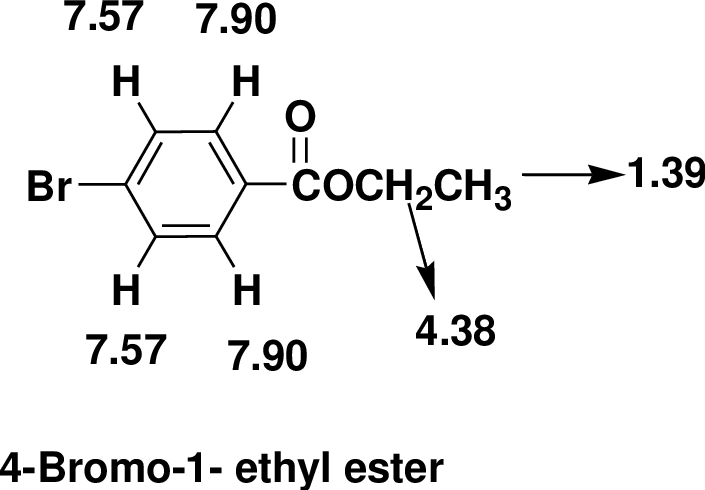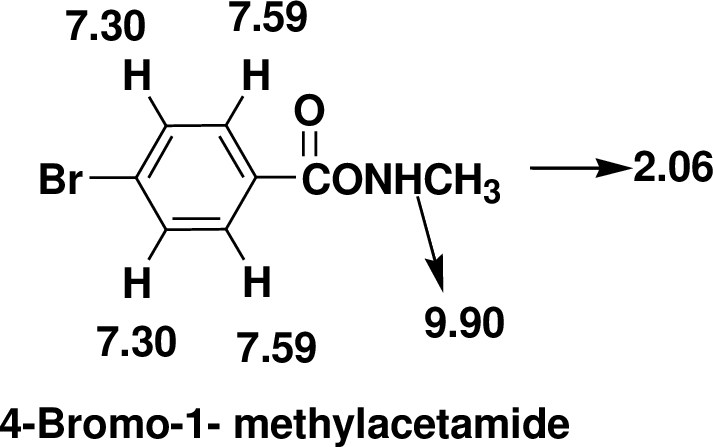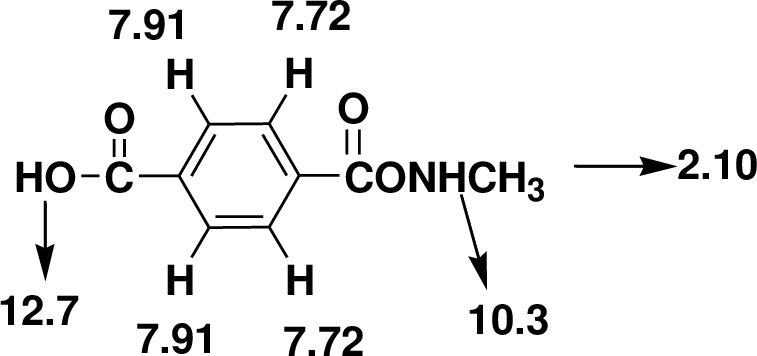
Concept explainers
(a)
Interpretation:
The strucutral formula for each of the given compound has to be proposed using the given NMR data.
Concept Introduction:
The
Chemical shift: The NMR spectrum of any compound is taken with reference to a standard compound called reference compound. Generally, tetramethylsilane (TMS) is taken as the reference compound. The methyl protons of TMS are equivalent and produces only one sharp peak at the rightmost end of the scale.
13C NMR Spectroscopy: This type of NMR splitting of signals tells us numbers of hydrogens atoms are attached to each carbon. The triangle rule (n+1) C. The chemical shift explains the different hybridization
(a)
Explanation of Solution
Index of Hydrogen Deficiency (IHD) calculation,
Given molecular formula F is
We calculate the
From the molecular formula
The one signal in the
There are also one
Therefore, the based on above spectral details the structure that is consistent with the all of these facts is 4-Bromo-1- ethyl ester.

(b)
Interpretation:
The strucutral formula for each of the given compound has to be proposed using the given NMR data.
Concept Introduction:
The
Chemical shift: The NMR spectrum of any compound is taken with reference to a standard compound called reference compound. Generally, tetramethylsilane (TMS) is taken as the reference compound. The methyl protons of TMS are equivalent and produces only one sharp peak at the rightmost end of the scale.
13C NMR Spectroscopy: This type of NMR splitting of signals tells us numbers of hydrogens atoms are attached to each carbon. The triangle rule (n+1) C. The chemical shift explains the different hybridization
(b)
Explanation of Solution
Index of Hydrogen Deficiency (IHD) calculation,
Given molecular formula F is
We calculate the
From the molecular formula
The one signal in the
There are also one
Therefore, the based on above spectral details the structure that is consistent with the all of these facts is 4-Bromo-1- methylacetamide.

(c)
Interpretation:
The strucutral formula for each of the given compound has to be proposed using the given NMR data.
Concept Introduction:
The
Chemical shift: The NMR spectrum of any compound is taken with reference to a standard compound called reference compound. Generally, tetramethylsilane (TMS) is taken as the reference compound. The methyl protons of TMS are equivalent and produces only one sharp peak at the rightmost end of the scale.
13C NMR Spectroscopy: This type of NMR splitting of signals tells us numbers of hydrogens atoms are attached to each carbon. The triangle rule (n+1) C. The chemical shift explains the different hybridization
(c)
Explanation of Solution
Index of Hydrogen Deficiency (IHD) calculation,
Given molecular formula F is
We calculate the
From the molecular formula
The one signal in the
There are also one
Therefore, the based on above spectral details the structure that is consistent with the all of these facts is acid substituted phenylacetamide.

Want to see more full solutions like this?
Chapter 21 Solutions
Organic Chemistry
- Identify and provide a concise explanation of the concept of signal-to-noise ratio (SNR) in the context of chemical analysis. Provide specific examples.arrow_forwardIdentify and provide a concise explanation of a specific analytical instrument capable of detecting and quantifying trace compounds in food samples. Emphasise the instrumental capabilities relevant to trace compound analysis in the nominated food. Include the specific application name (eg: identification and quantification of mercury in salmon), outline a brief description of sample preparation procedures, and provide a summary of the obtained results from the analytical process.arrow_forwardIdentify and provide an explanation of what 'Seperation Science' is. Also describe its importance with the respect to the chemical analysis of food. Provide specific examples.arrow_forward
- 5. Propose a Synthesis for the molecule below. You may use any starting materials containing 6 carbons or less (reagents that aren't incorporated into the final molecule such as PhзP do not count towards this total, and the starting material can have whatever non-carbon functional groups you want), and any of the reactions you have learned so far in organic chemistry I, II, and III. Your final answer should show each step separately, with intermediates and conditions clearly drawn. H3C CH3arrow_forwardState the name and condensed formula of isooxazole obtained by reacting acetylacetone and hydroxylamine.arrow_forwardState the name and condensed formula of the isothiazole obtained by reacting acetylacetone and thiosemicarbazide.arrow_forward
- Provide the semi-developed formula of isooxazole obtained by reacting acetylacetone and hydroxylamine.arrow_forwardGiven a 1,3-dicarbonyl compound (R1-CO-CH2-CO-R2), indicate the formula of the compound obtaineda) if I add hydroxylamine (NH2OH) to give an isooxazole.b) if I add thiosemicarbazide (NH2-CO-NH-NH2) to give an isothiazole.arrow_forwardAn orange laser has a wavelength of 610 nm. What is the energy of this light?arrow_forward
- The molar absorptivity of a protein in water at 280 nm can be estimated within ~5-10% from its content of the amino acids tyrosine and tryptophan and from the number of disulfide linkages (R-S-S-R) between cysteine residues: Ε280 nm (M-1 cm-1) ≈ 5500 nTrp + 1490 nTyr + 125 nS-S where nTrp is the number of tryptophans, nTyr is the number of tyrosines, and nS-S is the number of disulfide linkages. The protein human serum transferrin has 678 amino acids including 8 tryptophans, 26 tyrosines, and 19 disulfide linkages. The molecular mass of the most dominant for is 79550. Predict the molar absorptivity of transferrin. Predict the absorbance of a solution that’s 1.000 g/L transferrin in a 1.000-cm-pathlength cuvet. Estimate the g/L of a transferrin solution with an absorbance of 1.50 at 280 nm.arrow_forwardIn GC, what order will the following molecules elute from the column? CH3OCH3, CH3CH2OH, C3H8, C4H10arrow_forwardBeer’s Law is A = εbc, where A is absorbance, ε is the molar absorptivity (which is specific to the compound and wavelength in the measurement), and c is concentration. The absorbance of a 2.31 × 10-5 M solution of a compound is 0.822 at a wavelength of 266 nm in a 1.00-cm cell. Calculate the molar absorptivity at 266 nm.arrow_forward
 Organic ChemistryChemistryISBN:9781305580350Author:William H. Brown, Brent L. Iverson, Eric Anslyn, Christopher S. FootePublisher:Cengage Learning
Organic ChemistryChemistryISBN:9781305580350Author:William H. Brown, Brent L. Iverson, Eric Anslyn, Christopher S. FootePublisher:Cengage Learning
